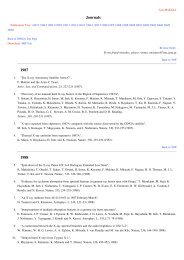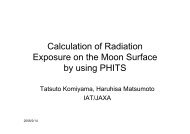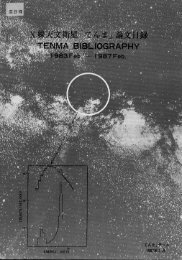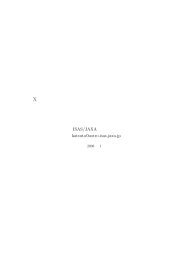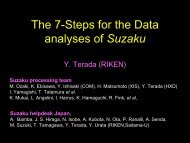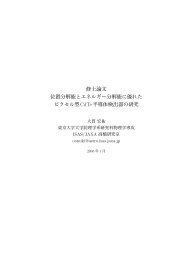2006-34: The X-ray Telescope onboard Suzaku - HEASARC - NASA
2006-34: The X-ray Telescope onboard Suzaku - HEASARC - NASA
2006-34: The X-ray Telescope onboard Suzaku - HEASARC - NASA
Create successful ePaper yourself
Turn your PDF publications into a flip-book with our unique Google optimized e-Paper software.
Table 3. Best-fit parameters of the power law model to the Crab spectra taken in 2005 September 15-16.Sensor ID N HaPhoton Index Normalization b Flux c χ 2 ν (d.o.f.)XIS-default positionXIS0 0.35±0.01 2.13±0.02 10.48 +0.27−0.26 2.15 0.97 (199)XIS1 0.30±0.01 2.07±0.02 9.52±0.23 2.14 1.27 (217)XIS2 0.33±0.01 2.09±0.02 10.09 +0.26−0.25 2.19 1.05 (200)XIS3 0.<strong>34</strong>±0.02 2.07±0.02 9.46 +0.25−0.24 2.13 1.11 (197)HXD-default positionXIS0 0.35±0.02 2.14±0.02 9.79 +0.31−0.30 1.97 1.21 (155)XIS1 0.29±0.02 2.09±0.02 8.90 +0.27−0.26 1.94 1.07 (170)XIS2 0.33±0.02 2.10±0.02 9.89 +0.28−0.27 2.13 1.03 (181)XIS3 0.32±0.02 2.06±0.02 9.38 +0.27−0.26 2.15 1.19 (180)a Hydrogen column density in a unit of 10 22 cm −2 .b Power-law normalization in a unit of photons cm −2 s −1 keV −1 at 1 keV.c Energy flux in a unit of 10 −8 cm −2 s −1 in the 2-10keV band.Toor & Seward (1974) compiled the results from a number of rocket and balloon measurementsavailable at that time, and derived the photon index and the normalization of thepower law of the Crab nebula to be 2.10 ± 0.03 and 9.7 photons cm −2 s −1 keV −1 at 1 keV,respectively. Overlaying photoelectric absorption with N H = 3 × 10 21 cm −2 , we obtain the fluxto be 2.09 × 10 −8 erg cm −2 s −1 in the 2–10 keV band. <strong>The</strong> best-fit parameters of all the XISmodules at the XIS-default position are close to these standard values. Although those at theHXD-default position show similar values, the fluxes of XIS0 and XIS1 are smaller than thestandard value by 6–7 %. Since the optical axes of these two detectors are farther away fromthe HXD-default position than those of the other two (Fig. 8), this may be due to insufficientcalibration of the optical axes and/or the vignetting (§3.3).Since the best-fit parameters of the four XIS modules are close to the standard values, wehave attempted to constrain the hydrogen column density and the photon index to be commonamong all the detectors. <strong>The</strong> best-fit parameters are summarized in table 4. <strong>The</strong> hydrogencolumn density (0.32–0.33)×10 22 cm −2 and the photon index 2.09±0.01 are consistent with thestandard values.Finally we would like to remark on our choice of the background-integration region.Since the background-integration region is taken at the very edge of the XIS field of view, onemay suspect possible under-subtraction of the background due to vignetting effects (§3.3) onthe background spectra. We thus have analyzed the data of MBM12 (Lynds 1457) off-cloudobservation carried out from <strong>2006</strong> February 6 through 8 (Smith et al. <strong>2006</strong>). <strong>The</strong> originalpurpose of this observation was to collect reliable background data for the main MBM12 observation.<strong>The</strong> pointing direction (l,b) ≃ (157. ◦ 3,−36. ◦ 8) is close to anti-galactic center like the15




